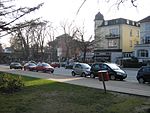Loki-Schmidt-Garten
Botanical gardens in GermanyBuildings and structures in Altona, HamburgGardens in HamburgGerman garden stubsHamburg building and structure stubs ... and 1 more
University of Hamburg

The Loki-Schmidt-Garten, also known as Botanischer Garten Hamburg, or, more formally, as Botanischer Garten der Universität Hamburg or Biozentrum Klein Flottbek und Botanischer Garten, is a botanical garden maintained by the University of Hamburg. It has a size of around 25 hectares and is located at Ohnhorststrasse 18, Hamburg, Germany, beside the Klein Flottbek station in the Osdorf quarter, and open daily without charge. It was renamed in 2012 after Loki Schmidt, the wife of the former German chancellor Helmut Schmidt. Though it was renamed, the old name coexists with the new one. Nearby Klein Flottbek station still has the second name "Botanischer Garten".
Excerpt from the Wikipedia article Loki-Schmidt-Garten (License: CC BY-SA 3.0, Authors, Images).Loki-Schmidt-Garten
Wüstenwanderweg, Hamburg Osdorf (Altona)
Geographical coordinates (GPS) Address Nearby Places Show on map
Geographical coordinates (GPS)
| Latitude | Longitude |
|---|---|
| N 53.5622 ° | E 9.8611 ° |
Address
Cafe Palme
Wüstenwanderweg
22609 Hamburg, Osdorf (Altona)
Germany
Open on Google Maps









